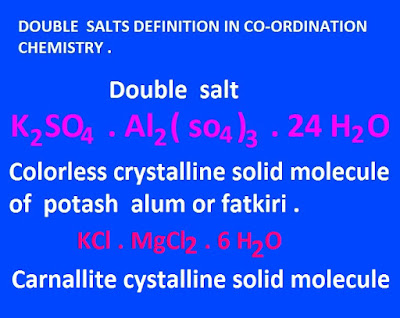Double salts-definition-examples and properties in co-ordination chemistry .
Double salts definition in co-ordination chemistry
When two or more simple salts in stoichimetric proportions are attached to each other, resulting in the formation of a molecular salt which exist only in solid crystal state but
dissociate into their constituent compound in water or any other solvents, then this type of molecular compound is called double salt.
Double salt examples.
Double salt compounds is a type of molecular compound or higher order compound which produced from first order compounds.
There are
many man made as well as natural
occurring well known double salt compounds
in co-ordination chemistry. Such as Carnallite, potash alum Mohr’s
salt etc.
If a solution of ferrous sulfate and ammonium sulfate in their stoichimetric proportions are allowed to evaporate,
then a light green color molecular compound, ferrous ammonium sulfate hexahydrate
with molecular formula FeSO4, (NH4)2 SO4,
6H2O is obtained.
The resulting double salt is also known as Mohr’s salt. In the similar way, potash alum is made from the stoichimetric proportions of aluminium sulfate and potassium sulfate salt.
On the other
hand, naturally occurring double salt, carnallite consist of potassium chloride and magnesium
chloride.
Double salt compound properties.
( I ) Double salt are molecular or higher order
compound which is formed by the attachment of two or more simple
salt.
( II )
Double salt can only exist in solid state.
( III ) They are completely ionize in aqueous
solution or any other solvents.
(IV ) Double
salts are soluble in water.
(V) They do not exhibit isomerism properties.
( VI ) Each double salt molecule contains one or
more crystal water molecule .
Summary
- What is double salt in co-ordination in chemistry ?
- Examples of double salts .
- What is basic properties of double salt ?











No comments